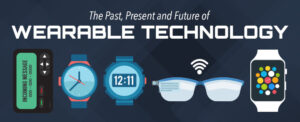
Wearable technology (portable technology or technology to wear), refers to clothing or accessories that incorporate electronic or technological elements. The most notorious example is Google Glass, a development of the information giant in the form of glasses that allow the visualization of augmented reality. The same classification includes GoPro cameras, wireless gloves for remote devices, biometric readers, jewellery, smart watches and virtual reality devices. In 2013, about 13 million of these devices were ordered online and that number is expected to increase to 170 million in 2018. According to a study, in 2014 about 10 million devices will be sold, such as watches, bracelets and glasses with wearable technology, worldwide.
This technology can increase children’s ability to be more creative and innovative. Bill Gates states in a study published on the Microsoft website that new technologies can offer unparalleled opportunities to improve the educational environment for the benefit of students, teachers and school administrative staff. Students and teachers can participate in virtual classes that cross borders and exploit the resources of any institution that has internet.
Every teacher has ever wondered if their students are understanding what they have explained. In the future they could know exactly: companies like Muse have developed sensors that connect with the brain activity of students and transmit in real time to a smart phone to a tablet what activities they understand and which do not.
Although the costs of this technology are still too high to include them massively in the education system, it won’t be long before they become part of the students’ daily lives. In fact, hundreds of educational institutions in the United States in their implementation have discovered through experience that there are endless possibilities for learning through them.
Technological clothing is not just outfits
The secret will be to connect this technology with a real use of it, for example: by involving it in training projects, as is the case with the Logistics Development Association. However, at the moment, the applications for the area of health are those that advance in tip and also contemplate a formative quota. Indeed, doctors see these devices as an extraordinary opportunity to educate and engage patients with their health.
The consolidation of technological clothing (wearable technology) and mobile sensors constitute a worldwide trend of massive penetration and a great opportunity for both product manufacturers and electronic service developers. What is it about? Bracelets, watches and sensors that we carry in the body, which, connected to a mobile phone, acquire amazing uses and capacities to measure all kinds of variables, which can be subsequently monitored from the cloud.
Google Glass
Google Glass stands out among the first wearable used for training projects. However, while still experiencing the potential use for educational purposes of other similar devices, such as the use of bracelets for educational purposes, discussed below. Among the ‘technological clothing’, the dissemination of these products is currently being highlighted: Google Glass , Galaxy Gear Watch (Samsung) , the TalkBrand device (Huawei) , the One SmartBand SWR10 bracelet (Sony Mobile and Telefónica) – which notifies to the user when he receives a call, a message or interactions in social networks, Life Band Touch (LG) – which monitors the daily activity and allows to control the user’s mobile phone, and the Pebble smart watch.
Wearable: mobility in education
To analyze the impact that this technology is having on education and training, we consult a group of international specialists. The most important contribution that we see in the implementation of Google Glass in education is the ability to receive audio-visual information directly in our senses, without these being blocked, as happens when we look at a screen, or hear something through of headphones, as well as being able to dispose of the hands with total freedom. This opens up an incredible range of possibilities when it comes to receiving personalized training, in real time and with practical application on what we are visualizing.
An example could be a course on handling electric trucks, where after receiving all the necessary theory, the operator could focus on the truck he drives in his company, or look at a code that serves to identify that truck, and that will automatically search that model in the course database, and will show us a series of defined procedures, for example, the start-up. When viewing the forklift through the GG could indicate, on the real image of our truck, the sequence to be carried out for the start of the same.
The use of wearable devices in some areas, such as physical education, is very natural. For example, today with Fitbit (although this quantified is not strictly a wearable device) and the like, you could monitor the exercise that students do and educate about the importance of practicing sport regularly. In the case of smart watches and other wearable such as Google Glass, its use is more uncertain. But if these devices finish fitting into the public, we will soon see applications of all kinds. Imagine the practical possibilities that could occur, for example, in a medical school class.
